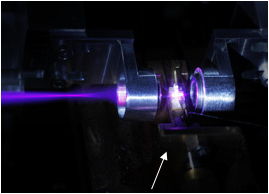Sony Develops Powerful Laser for 1TB Optical Disc
Let's hope Sony doesn't get the idea of attaching these things onto sharks.
The Blu-ray Disc Association may have just passed the BDXL specification that expands that capacity of Blu-ray media to 100GB, but the real roomy optical format of the future is being developed in a lab in Japan right now.
Sony and Tohoku University have created a laser that has a beam output that's in excess of 100 watts, which is more than a hundred times the world’s highest output value for conventional blue-violet pulse semiconductor lasers.
This latest successful development is an all-semiconductor laser picosecond pulse source with a laser wavelength of 405 nanometers (1 nm = one-billionth of a meter) in the blue-violet region. It is capable of generating optical pulses in the ultrafast duration of 3 picoseconds (1 picosecond = one-trillionth of a second), with ultrahigh output peak power of 100 watts and repetition frequency of 1 gigahertz.
What's even more remarkable, boasts Sony, is that that other ultra high-output laser devices require a bulky light source box and a specialist technician to ensure the stable operation of the laser. This technology, however allows for a much smaller lightbox and perhaps for a more automated process.
Sony said that it has already tested applying this technology in next-generation large-capacity optical disc-storage, which could mean capacities 20 times greater than what we have now.
This laser technology could also be applied to a wide range of fields such as three-dimensional (3D) nano-fabrication of inorganic/organic materials.
Get Tom's Hardware's best news and in-depth reviews, straight to your inbox.
-
wolfram23 Cool, I guess. I just hope they're not planning to use it on PS4... they need to go all digital.Reply -
dark_lord69 Cool, but I'd be surprised if this comes out anytime soon... but for it to compete with large hard drives it needs to come out soon enough. I wouldn't be surprised if it was going to be used in the PS4.Reply -
sirmorluk Looks like my sharks will finally get that upgrade they have been asking for. :)Reply
Seriously though. 100w@1Ghz is friggin impressive. -
back_by_demand I can imagine putting a disc in the machine, pressing burn and it fires straight though the bottom of the PC, through the floorboards and blasts a hole 60 feet into the ground.Reply -
chickenhoagie i'll just go ahead and put my PC on cruise control while i burn 1TB of my music onto a disc..I'll see you all in a couple of weeks! :)Reply -
bildo123 Wolfram23Cool, I guess. I just hope they're not planning to use it on PS4... they need to go all digital.Reply
Pretty sure Blu-Ray isn't analog...neither is this... -
mavroxur Wolfram23they need to go all digital.Reply
Apparently you're new to the world of optical discs....

